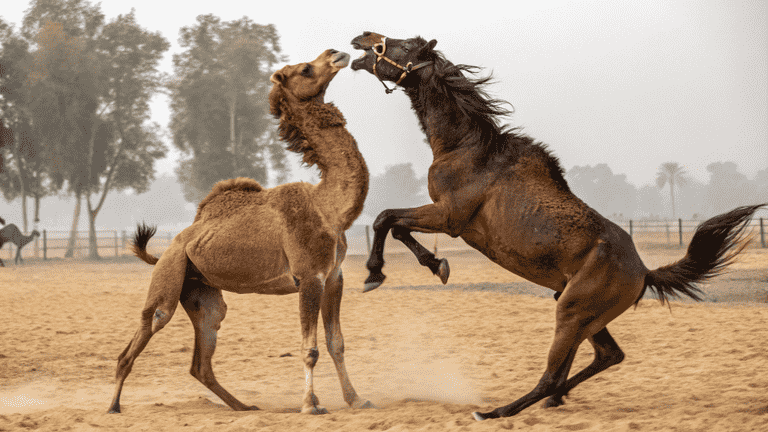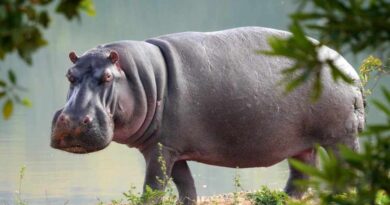Camel vs Horse Size: Surprising Height & Weight Differences [2025]
Camel vs horse size differences are far more dramatic than many people realize. When standing side by side, dromedary camels tower over most horses, reaching heights of (5.8 to 7.5 feet) at the shoulder compared to the average horse’s 152 to 163 cm (15 to 16 hands). Despite their imposing stature, horses can actually outrun camels in a sprint, reaching impressive speeds of 88 km/h (55 mph) while camels top out at 65 km/h (40 mph) in short bursts.180 to 230 cm
Weight comparisons between these magnificent animals also reveal surprising contrasts. In general, dromedary camels weigh between 300 and 690 kg (661 and 1,521 lbs), which is frequently more than the average weight of horses, which is 400 to 500 kg. However, certain horse breeds like Shires and Clydesdales can rival camels in size, standing 170 to 190 cm tall at the shoulder. Furthermore, these animals differ dramatically in longevity, with camels living 40 to 50 years compared to horses’ 25 to 30 years. In this comparison guide, we’ll explore what makes these desert and grassland giants uniquely adapted to their environments and how their physical differences affect their capabilities.
Camel vs Horse: Height and Weight Breakdown
Standing next to one another, camels and horses present striking physical differences beyond their distinctive silhouettes. The size disparity between these majestic animals reveals their evolutionary adaptations to different environments.
Average Height: 5.3 ft vs 6.2 ft at Shoulder
When measuring camel vs horse size at the shoulder, camels clearly stand taller. Dromedary camels reach and 1.7–1.9 meters (5.6-6.2 feet) for females. This notably exceeds the average horse, which typically stands about 1.52-1.63 meters (5-5.3 feet) at the withers. Most riding horses measure approximately 5 feet at the withers, though certain breeds reach greater heights. This height difference becomes immediately apparent when both animals stand side by side.1.8–2.0 meters (5.9-6.6 feet) at the shoulder for males
Weight Range: 900–2200 lbs vs 880–1500 lbs
The weight comparison between these animals reveals interesting variations. Horses generally range from , with many riding horses averaging 400-500 kg (880-1100 lbs). Dromedary camels typically weigh between 300-690 kg (660-1520 lbs) for males and 300-540 kg (660-1190 lbs) for females. Bactrian camels can be substantially heavier, weighing between 660-2200 pounds. Interestingly, despite horses sometimes outweighing camels, the latter can typically carry heavier loads.900-2200 pounds (410-1000 kilograms)
Hump Height: Up to 7 ft in Dromedaries
The distinctive hump adds considerable height to camels. A full-grown dromedary stands approximately 2.15 meters (7.1 feet) at the hump, with the hump itself measuring at least 20 cm (7.9 inches) tall. This feature gives dromedaries their imposing stature, making them appear even taller than their shoulder height suggests. The hump consists primarily of fat bound together by fibrous tissue, serving as both an energy reserve and a height advantage.
Breed Variations: Draft Horses vs Bactrian Camels
Significant size variations exist within both species. Draft horses weigh 1,400–2,000 pounds (640–910 kg) and are roughly 16–19 hands (64–76 inches; 163–193 cm) tall. Sampson, a Shire, was the tallest horse ever measured, being 21.2 hands (86 inches) tall.. Meanwhile, Bactrian camels measure 5.2-5.9 feet (1.57-1.8 meters) at the shoulder but can reach 7 feet tall at their humps and weigh up to 1,600 pounds at maturity. These two-humped camels, although shorter at the shoulder than dromedaries, remain impressively large animals.
Body Structure and Physical Features
The physical architecture of camels and horses reveals evolutionary adaptations suited to their native environments. From foot structure to body shape, these differences help explain each animal’s unique capabilities.
Leg Anatomy: Slender Hooves vs Broad Padded Feet
Horses possess slender, well-defined legs ending in , primarily designed for swift movement across firm terrain. Their single-toed structure bears weight on the middle toe covered by a hard keratin hoof. Conversely, camels have sturdy legs with broad, flat, padded feet that distribute weight evenly across sandy surfaces. In contrast to horses, camels have short, bent toenails in place of actual hooves, and each foot has two toes joined by webbing. This specialized foot expands when bearing weight, functioning similarly to snowshoes on sand. Solid hooves
Tail and Mane: Long Flowing vs Short Tufted
The esthetic differences between these animals extend to their hair features. Horses typically display a long, flowing mane that grows along their neck, complemented by an equally impressive long, flowing tail. These features contribute to their graceful appearance during movement. Camels, alternatively, possess a shorter, coarser mane and a distinctly shorter, tufted tail. These compact features suit desert conditions, requiring less maintenance and water for grooming.
Muzzle Shape: Narrow vs Rounded
Facial structure varies significantly between species. Horses feature a narrower, more pointed muzzle with a wedge-shaped skull. Their mouthpiece is typically 1.3 cm narrower than those of similar-sized animals. Meanwhile, camels have a broader, more rounded muzzle with a thick leathery lining inside their mouth, allowing them to consume thorny desert plants without injury.
Neck and Back: Straight Spine vs Humped Back
Perhaps most distinctive is the spinal structure. Horses maintain a relatively straight back with a short-coupled frame, ideally displaying a 1:2 ratio between topline and underline. Essentially, horses have a uniform body shape suited for speed. Camels, furthermore, feature their iconic humped back—storing fat rather than water—which affects their center of gravity. This adaptation provides energy reserves for harsh desert environments, with dromedaries having one hump and Bactrian camels possessing two.
Speed, Strength, and Endurance
Beyond their distinctive physical appearances, camels and horses display remarkable differences in performance capabilities that directly impact their utility. These performance metrics reveal how each animal has specialized for survival in their native environments.
Top Speed: 55 mph vs 40 mph
In raw speed competitions, horses consistently outpace camels. In brief spurts, horses may achieve remarkable speeds of 88 km/h. Camels, consequently, top out at approximately 40 miles per hour (64 km/h)[131]. Nevertheless, both animals maintain similar sustained speeds of about 25 miles per hour over the course of an hour. For extremely long journeys, camels can travel steadily at 12 miles per hour for up to 18 hours without rest. Up to 55 miles per hour
Endurance in Harsh Conditions: Desert Camel Adaptations
What camels lack in top speed, they compensate for with exceptional endurance. These desert specialists can travel for days without water and survive catastrophic droughts that would kill most other livestock. Indeed, camels can endure extreme dehydration, losing up to 25-30% of their body weight—twice what would be fatal for most mammals. Upon finding water, a thirsty camel can rehydrate within minutes, absorbing over 100 liters in just 5-10 minutes.
Load Carrying Capacity: 220 lbs vs 1000 lbs
Despite size similarities, load-bearing capacities differ substantially. Dromedary camels typically carry 200-330 pounds (90-150 kg) for extended periods, occasionally handling loads up to 990 pounds in exceptional cases. Bactrian camels can transport over 440 pounds (200 kg) for 31 miles daily. In contrast, horses generally carry only up to 20% of their body weight, meaning even a large 2,000-pound horse would max out at around 400 pounds of cargo.
Are Camels Stronger Than Horses?
The answer depends on the definition of strength. Regarding raw pulling power, horses typically demonstrate greater muscle strength for short bursts. Alternatively, for sheer endurance and weight-bearing capacity, especially in harsh environments, camels clearly dominate. This specialized strength allows camels to maintain effectiveness over long distances through desert terrain where horses would quickly fatigue.
Real-World Use and Habitat Adaptation
Evolutionary pathways have shaped camels and horses into specialists perfectly suited for their native environments, with adaptations affecting their practical uses throughout history.
Desert Camel vs Grassland Horse: Environmental Fit
The desert camel possesses remarkable survival adaptations for arid conditions. Their thick, coarse outer coat shields them from scorching sun and sandstorms, while their broad, padded feet distribute weight over shifting sands to prevent sinking. Camels can withstand body temperature fluctuations up to 6°C and endure water losses of 30% body mass – twice what would kill most mammals. In contrast, horses evolved for open grasslands and temperate climates with slender builds and solid hooves designed for efficient heat dissipation during physical exertion.
What Do Camels Eat vs Horse Diet
Dietary preferences reflect habitat specialization. Camels browse on thorny, dry vegetation that other animals avoid, using specialized lips to grasp plants with minimal waste. They primarily consume salsola, wormwood, and other plants rarely eaten by other animals. Notably, one kilogram of dry desert plants contains 0.4-0.5 nutrient units and 110-120g of digestible protein. Horses, alternatively, graze on tender grasses in open areas, utilizing front teeth to pull and back teeth to slice vegetation. Their higher energy requirements necessitate a richer carbohydrate and protein intake than camels.
Domestication and Utility: Transport, Sport, and Labor
Both animals transformed human civilization. Camels, with their ability to carry up to 145kg over 40km daily without water for six days, were crucial for ancient trade routes like the Silk Road. Horses revolutionized warfare and transportation, with their digestive system allowing them to graze and walk continuously all day. During World War I, Australia shipped over 120,000 horses overseas, with 39,000 serving in the Australian Light Horse.
Are Camels Related to Horses?
Horses and camels do not have a close evolutionary link, despite their outward resemblance. Camels belong to the Camelidae family (even-toed ungulates), while horses are in the Equidae family (odd-toed ungulates). Their last common ancestor lived approximately 78 million years ago. This explains their fundamentally different anatomical structures, including foot design and digestive systems.
Comparison Table
Characteristic Horse Camel (Dromedary) Shoulder Height 152-163 cm (5-5.3 ft) 180-230 cm (5.8-7.5 ft) Weight Range 900-2,200 lbs (410-1,000 kg) 660-1,520 lbs (300-690 kg) Maximum Speed 88 km/h (55 mph) 65 km/h (40 mph) Load Carrying Capacity Up to 220 lbs (20% of body weight) Up to 1,000 lbs (330-990 lbs) Lifespan 25-30 years 40-50 years Foot Structure Single-toed with solid hooves Two-toed with broad, padded feet Mane & Tail Long, flowing Short, tufted Muzzle Shape Narrow, pointed Broad, rounded Back Structure Straight spine Humped (single or double) Sustained Travel Speed 25 mph (for 1 hour) 12 mph (for up to 18 hours) Primary Habitat Grasslands, temperate climates Desert, arid regions Diet Type Grazing (tender grasses) Browsing (thorny, dry vegetation) Conclusion
The comparison between camels and horses reveals fascinating adaptations that showcase nature’s remarkable design for different environments. Despite appearing similar from a distance, these magnificent animals differ significantly in height, weight, speed, and physical structure. Camels tower over most horses at the shoulder, reaching heights of 180-230 cm compared to the average horse’s more modest 152-163 cm stature. Horses, however, demonstrate superior speed capabilities, reaching impressive bursts of 88 km/h while camels top out at 65 km/h.
Perhaps most notably, their physical structures tell the story of their evolutionary paths. Horses developed slender legs with solid hooves perfectly suited for swift movement across firm grasslands. Camels, conversely, evolved broad, padded feet that distribute weight evenly across shifting desert sands. These adaptations extend to their entire bodies—from the horses’ flowing manes and tails to the camels’ distinctive humps and rounded muzzles.
Though horses exhibit greater raw speed and pulling power for short bursts, camels undoubtedly dominate in endurance and load-bearing capacity. We can observe how a camel carries up to 990 pounds while enduring extreme conditions that would quickly exhaust even the hardiest horse. Additionally, camels demonstrate remarkable longevity, living 40-50 years compared to the 25-30 year lifespan of horses.
Throughout history, both animals transformed human civilization in profound ways. The camel’s unparalleled desert adaptations enabled trade routes across seemingly impassable terrain, while the horse’s speed and versatility revolutionized transportation, warfare, and agriculture across grasslands and temperate regions. Ultimately, rather than declaring one superior to the other, this comparison highlights how perfectly each animal adapted to thrive in its native environment—a testament to the specialized evolution that makes both camels and horses extraordinary in their own right.
FAQs
Q1. How do camels and horses compare in size?
A1. Camels are generally taller than horses, with dromedary camels reaching 5.8 to 7.5 feet at the shoulder compared to the average horse’s 5 to 5.3 feet. However, horses can sometimes outweigh camels, with a weight range of 900-2200 pounds versus 660-1520 pounds for dromedaries.
Q2. Which animal is faster: a camel or a horse?
A2. Horses are faster than camels in short bursts. Horses can reach speeds of up to 55 mph (88 km/h), while camels top out at about 40 mph (65 km/h). However, camels have superior endurance and can maintain a steady pace for longer periods.
Q3. How do the feet of camels and horses differ?
A3. Horses have single-toed feet with solid hooves, designed for swift movement on firm ground. Camels, on the other hand, have two-toed feet with broad, padded soles that help distribute their weight on sandy surfaces, similar to snowshoes.
Q4. What are the main differences in diet between camels and horses?
A4. Camels are browsers that can eat thorny, dry vegetation that other animals avoid. They have specialized lips to grasp plants efficiently. Horses are grazers that prefer tender grasses in open areas, using their front teeth to pull and back teeth to slice vegetation.
Q5. How do camels and horses compare in terms of load-carrying capacity?
A5. Camels have a significantly higher load-carrying capacity compared to horses. Dromedary camels can typically carry 200-330 pounds for extended periods, with some capable of handling up to 990 pounds in exceptional cases. Horses, however, are generally limited to carrying about 20% of their body weight, which for a large 2,000-pound horse would be around 400 pounds.



